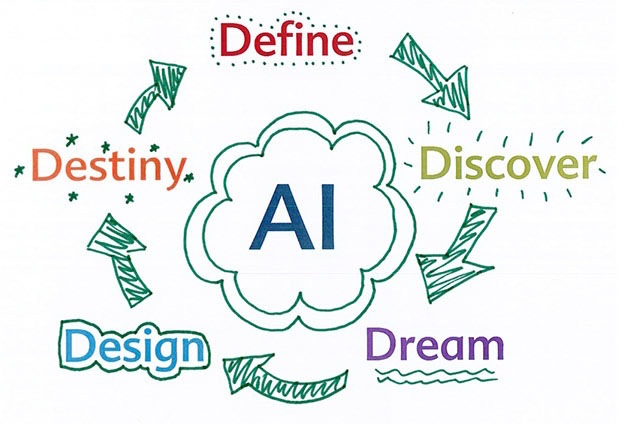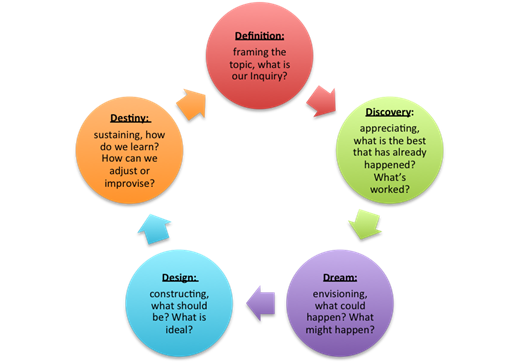
Organisations are full of stories and story telling. What people say to each other in corridors and canteens will often become the accepted reality. Unfortunately, this can mean that gossip and misinformation behind a new policy or strategy is better remembered than the details and contribution in the ‘thing’ itself. In much the same way, the more a problem is talked about – and framed as a problem – the more of a problem it becomes. If you’ve ever had a failing IT project, you’ll have experienced this. The new system has some glitches. But instead of persevering, people become increasingly disengaged with the system. Eventually you’ll have seen it spiral downwards and potentially be given up on or worked around. This is the power of story telling and if this happens too often in an organisation it can all too easily become the vortex of and overall negative culture.
However, telling stories and building on them can be a positive and purposeful approach. Such structured story telling and sharing can be very powerful in making waves, and making change for the good. There is an increasing body of evidence that building on strengths and what works can be a more powerful way to make any system work rather than focussing on weaknesses and fixing them. Applied systematically such an approach – systematically telling positive stories and building on strengths – is called Appreciative Inquiry.
Most organisations will be faced with problems of some kind, whether it’s because something has failed, or because rapid external changes mean processes or approaches are not likely to work the way they used to. Senior management then focus on the problem and how it might be fixed. They may engage others (whether internally or externally), delegate, or take on the problem themselves. However, by framing a situation as a problem, we are starting from a negative point. This means we must have done something wrong (or must now avoid doing wrong things). Such thinking can prevent the energy, enthusiasm and creative thought necessary to bring about real change. It drives a risk aversion approach.
Appreciative Inquiry on the other hand is a methodology that focuses on the positive – on what went right, on what was done well – and builds on these good news stories. This doesn’t make it fluffy, nice or easy. It’s more than just having a sunny outlook. It’s not about having a staff handbook full of positive phrases and managers giving lots of affirming feedback. Instead, it is grounded in reality – in the “what actually happened? What is really going on that works? How can we build on this?”
AI was developed by David Cooperrider and colleagues in the 1980s. It comes from a practical project. As part of his PhD, Cooperrider interviewed leading clinicians at the Cleveland Clinic in the USA about their greatest successes and failures with patients. Increasingly he found himself drawn more to the stories of success, as offering more insight, and eventually he decided to focus exclusively on those. When he reported his findings back to the Clinic staff organised into key themes, based around what worked, they had a huge impact on performance. In fact it improved performance to such an extent that the Clinic board asked him to use the same approach with the rest of organisation, to see what positive changes he could bring about more widely. From there Cooperrider and colleagues developed the AI methodology.
Appreciative inquiry into organisational life, he says, should have four characteristics. It should be:
An AI programme typically involves lots of people in the organisation inputting to meet Cooperrider’s ‘collaborative’ criteria. There are two ways to organise this:
What ever approach you adopt this is not a top down, or even bottom up methodology – but a real collective effort.
During the actual Appreciative Inquiry there are three key elements:
Element One: Identifying the positive core – begin by focussing on the positives, and not the problems. This means thinking about examples of excellence; understanding what enables and sustains the organisation; and realising the possibilities of success.
Element two: Working through the 5 Ds – setting up a cycle of questions and exploration that feedback to each other in a positive loop (Note there are some versions of AI which use 4 Ds). The 5 Ds are outlined below:

Element Three: – creating a kick-off point – a meeting, a feedback session – in which everyone is brought together to clarify what the next steps are.
These stages are explained in more detail below.
By following the 5D process, your organisation or project team can generate ideas, energise changes and stimulate innovation on a large scale. The following table explains how the Ds typically work:
| What does it mean? | How it’s done | |
|---|---|---|
| Definition | This phase is about framing the inquiry in a way that motivates and stimulates collective action, through curiosity. This can start with a “problem” (e.g. Donors have concerns and are unhappy with some aspects of our projects. They might take our funding away. ) This is turned into an appreciative topic (e.g. Our donors are committed to our projects and want them to be excellent. If we meet their standards they may want to fund more of our projects. So how do we improve our project work?) Note how AI starts with a desire to build on success in the framing of the challenge. | A workshop is held in which stories are told, and encouraged by a facilitator, not necessarily a senior manager or leader. Stories are themed into key topics. So in the example given themes might include:
|
| Discovery | This phase is all about finding out what has already made the appreciative topic possible (what has already thrilled our donors or made them want to support us and fund us). This is the story telling. This could be enough to bring about change – the story telling creates a positive mindset that then perpetuates itself. Alternatively this could culminate in a Summit (see below) – a more formal structure. | At the Summit, everyone is involved in collectively imagining what could be. This can involve exploring a question like “wouldn’t it be great if…?” This is not about presentations, but creative energy. So these ideas might be expressed through creative use of media like posters, little mini-dramas, poems and even songs. Small mixed group work is important here.
It’s not uncommon to combine other techniques like ‘World Café’ at this point. |
| Design | The purpose of the ‘design’ phase, which follows, is to turn those dreams into realities. The questions change at this point and ask: what do we/others need to do to make this dream possible? This could mean looking at policies, processes, structure and systems. This could also lead to new working practices, or specifc projects to test out new ways of working. | People state what they personally, and in their team, can and will do to make the dreams a reality – what they will change about their approach and attitudes.
They also think about what how they will embed action, on a daily basis. |
| Destiny | In this stage, people are asked to actually improvise and experiment with making practical changes.
This can be facilitated and guided by consultants or coaches. Changes are generally but not always incremental rather than revolutionary. |
At the ‘Summit’ event, anyone and everyone can bring forward ideas, or innovations, that will help bring the Design to life.
They must, however own those ideas since they and will be responsible for making them change day-to-day reality. You can only ask others to change by beginning with personal change. |
Appreciative Inquiry will typically (but not always) involve a Summit. This is not a big bang launch event, in which leaders explain what changes “will happen to” people. Instead it is a chance for real engagement at every level by holding a large scale, and often formal, event to involve people in the stages set out above.
Here the stories from the mass inquiry are told. While themed, and collated, these are not presented as such but told in core topics. From there, dream, design and destiny follow. Summits are best held off site, so that everyone can focus on the task at hand and not wander back to their desks and emails.
The key to making AI work at a really practical level is to make sure the 3 elements are structured in a way that makes it easy for people to get involved. Let’s take the example above and look at it in a bit more detail. The following explains how this international development organisation (“ID Charity”) has used AI to refocus their work, ensuring they remain a key policy advisor and source of excellent research for funders, donors and governmental agencies.
Element One: Identifying the positive core:
ID Charity has been developing advice, research and projects for over 30 years with great success. This means that their work is valued and important. This has attracted donors and funders for a long time, with strong relationships forged between organisations. Therefore, in the increasingly competitive arena of donor funding, this organisation is well placed to secure more funding for the great work they do.
Element two: Working Through the 5D’s:
Element Three: The kick-off:
The working group then hold another meeting, a feedback session – in which everyone is brought together to clarify what the next steps are. From this work, the destination is made a practical reality and embedded into every work stream and team work-plan.
=mc has used AI techniques in a number of settings in the UK and internationally. We’ve used it to help organisations as diverse as Amnesty International, National Trust for Scotland, UNICEF and Diabetes UK.
If you’ve found this article helpful and you would like more information, please call +44 (0)20 7978 1516 and speak to one of our experienced management consultants or contact us online.